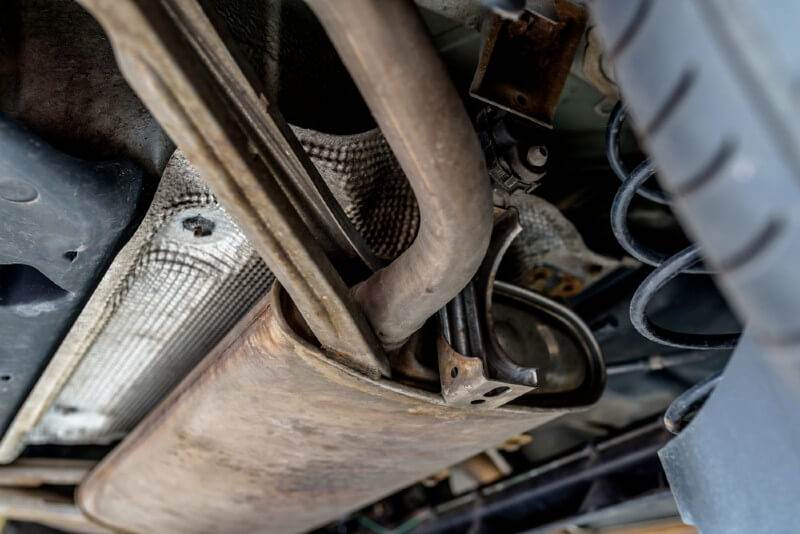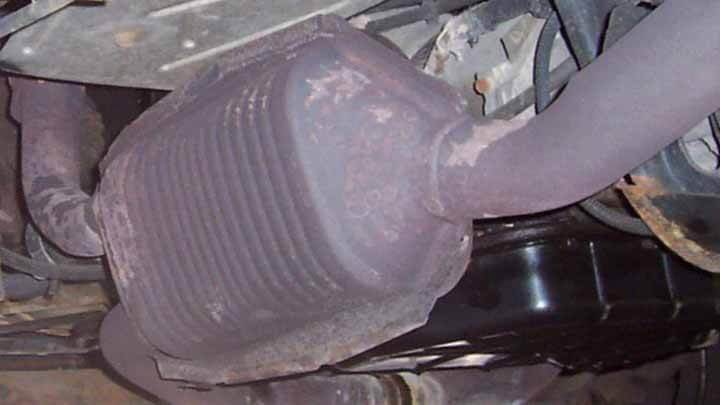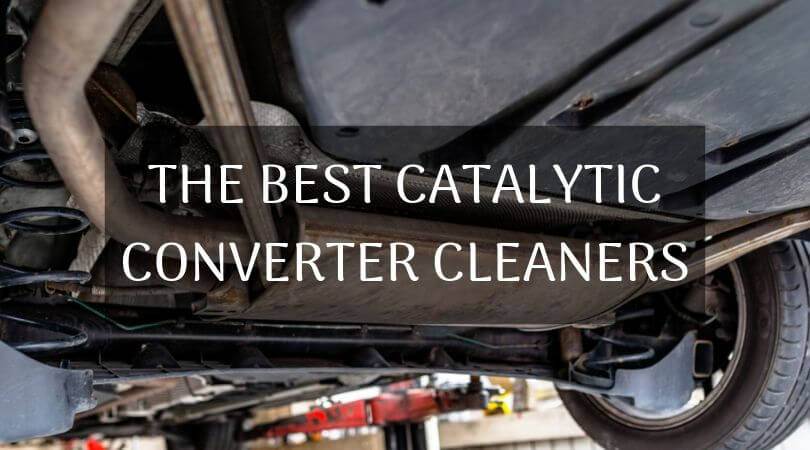The catalytic converter is a device that reduces harmful pollution from vehicle exhaust. It works by converting harmful carbons into less-toxic carbon dioxide and water. The computer or ECU in your vehicle is constantly monitoring the performance of the catalytic converter. It does so using the oxygen sensors. So when something goes wrong with the catalytic converter, the check engine light turns on.
But when this happens, what are you supposed to do? In this article, we will discuss the best catalytic converter cleaners along with a few helpful hints on how to properly diagnose a failing catalyst.
Having Problems With The Catalytic Converter?

Here’s the real deal: you wouldn’t really know if the catalytic converter is the problem in the first place. The symptoms of a broken or bad catalytic converter are similar to other engine problems such as clogged injectors, vacuum leaks, or faulty sensors. Even if your vehicle has a check engine light and P0240 trouble code, it doesn’t necessarily mean the converter is failing. For all you know, the problem might be triggered by broken oxygen sensors.
It takes a true professional to scan the ECU, understand the readings, interpreting the trouble codes, and analyzing the source of the problem. In the case of the P0420 code, the last thing to check should be the catalytic converter.
Add to the fact the catalytic converter is designed to last the life of the vehicle, and it all gets more confusing. Of course, nothing is perfect. In some cases, a 20-year old vehicle won’t have any problems with the catalytic converter. But this is not always the case.
When the catalytic converter goes bad prematurely, it must be caused by external damage (if the catalytic converter is dented or punctured by rocks or road debris), internal engine problems (caused by a bad head gasket so the engine burns oil, coolant, or both), or your vehicle got a faulty or subpar unit from the factory.
So if you’re dealing with a bad catalytic converter, it wouldn’t hurt to clean it using the best catalytic converter cleaners. But this is like performing first-aid in an open wound. If you’re lucky, using a catalytic converter cleaner may be enough to remove the blockage and contaminants inside the unit. This holds true if the problem or check engine light is caused by an inefficient (rather than a defective or failing) catalytic converter.
Taking all of this into consideration, it is important to make sure that your vehicle problems are caused by the catalytic converter in the first place. You wouldn’t want to spend money on a new catalytic converter when all your vehicle needed was a new fuel injector. If you have any doubts, it wouldn’t hurt to consult a professional.
6 Best Catalytic Converter Cleaners Reviewed
| Product Name | Quality | Price | Our Rating |
|---|---|---|---|
| Motorkote Catalytic and Exhaust Treatment | A | $ | |
| MotorPower Care Catalytic Converter Cleaner | A | $$ | |
| Oxicat Oxygen Sensor and Catalytic Converter Cleaner | A | $$ | |
| Sledgehammer Catalytic Converter Fuel System and Rapid Induction Cleaner | A | $$ | |
| Cataclean Fuel and Exhaust System Cleaner | A | $$$ | |
| CAT-1 Catalytic Converter Cleaner | A | $ |
**Below, you’ll find our more detailed reviews, but you can also click the links above to see current prices or read customer reviews on Amazon.
1. Motorkote Catalytic and Exhaust Treatment
For all intents and purposes, the Motorkote Catalytic and Exhaust Treatment is a fuel additive. But the cleaning formula is engineered to protect and treat the catalytic converter and exhaust system from oil poisons. And when Motorkote say’s ‘oil poisons’, it means burnt engine oil and coolant in the exhaust.
This product is intended to be used before or prior to replacing the catalytic converter. The intensive cleaning formula reduces phosphorus and zinc retention levels in the catalyst inlet to improve overall efficiency. This catalytic converter cleaner will also clean the O2 sensors to further improve engine performance and fuel economy.
The Motorkote Catalytic and Exhaust Treatment is easy to use. A single 16-ounce bottle is enough to treat 16 gallons of fuel or 1 ounce per gallon. After pouring it in, drive the car for at least 20 miles. Best results are achieved after consuming all the treated fuel in the tank.
Pros
- Simple and economical to use
- Dissolves carbon deposits and gunk
- Friendly low price
Cons
- Not much
2. MotorPower Care Catalytic Converter Cleaner
The MotorPower Care Catalytic Converter Cleaner is formulated to remove soot and carbon deposits in the entire exhaust tract including the catalytic converter, O2 sensors, turbocharger, and EGR valve. Regular use will protect against further contamination. The powerful cleaning formula instantly removes existing deposits and helps prevent further contamination.
This product is easy to use. The trick is to observe the proper mixing ration. Pour the entire contents (250 ml) into a fuel tank filled with 15 gallons of fuel (or half tank). If the catalytic converter is severely clogged, you can mix the cleaner with lesser fuel.
This catalytic converter cleaner works as you drive the vehicle! Keep the vehicle running for 40 minutes and that’s it!
Pros
- Powerful cleaning action
- Safe for all gasoline engines
- Great low price
Cons
- Not much
3. Oxicat Oxygen Sensor and Catalytic Converter Cleaner
You probably heard of Oxicat before. This is one of the best catalytic converter cleaners in the market. The cleaner is safe and effective to use in all gasoline, diesel, and hybrid vehicles.
Oxicat utilizes advanced decarbonizing technology to clean the entire exhaust system. It easily dissolves soot and thick carbon deposits to instantly improve engine performance. However, Oxicat explicitly says their product is not a mechanic-in-a-can or some kind of fix-all miracle product. It will not repair existing leaks, but it cleans the entire fuel system in a single treatment!
Pros
- Lower price
- Advanced cleaning formula decarbonizes the entire exhaust system
- Safe for all petrol, diesel, and hybrid vehicles
Cons
- Not much
4. Sledgehammer Catalytic Converter Fuel System and Rapid Induction Cleaner
The Sledgehammer Catalytic Converter Fuel System kit is professional grade. It costs more than the other cleaners in this test, but you’re actually getting two products for the price. When used together, the intensive cleaning action of the Sledgehammer decarbonizing kit is strong enough to clean the intake and exhaust valves, fuel injectors, combustion chambers, oxygen sensors, and catalytic converter.
This is a two-step cleaning kit. First, pour the entire contents of the Sledgehammer fuel system treatment in half a tank of gasoline. Start the vehicle and let it idle. The next product is the Sledgehammer rapid-induction deposit cleaner. Simply hook up the cleaner to the vacuum line or intake tube in your vehicle and let it rip!
Pros
- Two products in one
- Cleans the valves, injectors, and O2 sensors
Cons
- It’s a bit pricey
5. Cataclean Fuel and Exhaust System Cleaner
This Cataclean Fuel and Exhaust System Cleaner comes in a larger 5-liter container. Now, you may think this is too much for just one car. But if you think about it, you’ll have more than enough cleaner to last for a whole year! This product is also great if you have a fleet of vehicles at your disposal.
Cataclean is formulated to clean and decarbonize the catalytic converter and oxygen sensors. And since it is also suitable for diesel engines, it can also clean the DPF or diesel particulate filter. It restores lost engine performance while improving acceleration, torque, and fuel economy.
The ideal ratio is to pour a quart of Cataclean into a tank with at least ¼ level of fuel. This roughly translates to 1 quart for every 8 gallons of fuel. After this, drive the vehicle normally (preferably at higher speeds in an open highway) and you’re done.
Pros
- Economical to use
- Cleans and decarbonizes the catalytic converter and O2 sensors
Cons
- It’s pricey (but you get a lot of cleaning product)
6. CAT-1 Catalytic Converter Cleaner
The CAT-1 Catalytic Converter Cleaner has a brilliant marketing strategy. The bottle says it helps eliminate the rotten egg odor in your exhaust. Truth be told, the smell of rotten eggs is one of the symptoms of a failing or broken catalytic converter.
But this product is not just about marketing. CAT-1 is an effective gas additive that cleans the oxygen sensors and catalytic converter. It also extends the time between tune-ups and may help your older vehicle pass the emissions test!
But the best part is the price. CAT-1 is among the most affordable catalytic converter cleaners in this list. If you’re looking to get the most bang for the buck, you know where to look.
Pros
- Cleans catalytic converter and oxygen sensors
- Easy to use
- Low price
Cons
- Not much
How To Diagnose A Bad Catalytic Converter

Because the catalytic converter is located under the vehicle, it’s difficult to assess or inspect the unit without removing it. But before getting your hands dirty, you can check the performance/condition of the catalytic converter by using an OBD2 scan tool.
It doesn’t matter if you have a wireless, wired, Bluetooth, or Wi-Fi OBD2 scanning device. As long as the device is capable of displaying live engine data, you’re golden!
Step 1: Plug-in the scan tool into your vehicle’s OBD2 port. It is usually located under the steering column.
Step 2: Start your vehicle and allow the engine to idle. In order to get the proper readings, working with a warm engine is recommended.
Step 3: Depending on the type of scanner, it can automatically scan the ECU for trouble codes or you might need to enter the make, model, and VIN number of your vehicle. But the point here is to read the trouble code that is stored in the CPU. This will also reveal the source of the check engine light in the dash.
Step 4: If the trouble code is P0420, P0421, P0422, P0423, or anything that has something to do with the catalytic converter, you are most likely dealing with a failing catalyst. After confirming the definition of the trouble code, proceed to the next step.
Step 5: Go to settings and choose Live Data. Take a look at the upstream and downstream O2 sensor readings. If the catalytic converter is working as intended, the upstream O2 sensor reading should reflect a fluctuating graph, which represents the engine switching between lean and rich mixtures. The downstream O2 sensor reading should be steady.
Step 6: With the vehicle idling and the scanner still connected, press the gas pedal and give the vehicle a couple of revs.
Step 7: Watch the downstream O2 sensor readings. If the steady line is fluctuating as you press the gas pedal, this means the catalytic converter is burned out or damaged.
After confirming the source of the trouble code and the faulty component, you can proceed in cleaning the catalytic converter as a precautionary measure. But after using the best catalytic converter cleaners and the check engine light remains lit (pointing to a P0420 trouble code), it is time to buy a new catalytic converter.
Can I Use Lacquer Thinner To Clean The Catalytic Converter?
If by this you mean dipping the catalytic converter in a bucket of lacquer thinner, then yes. In fact, removing the catalytic converter and cleaning it manually is the best way to go. In this way, you can also take a closer look at the inlet and outlet ports and check the metal body for scuffs, punctures, cracks, or damage.
But you can also use lacquer thinner as a fuel and exhaust cleaner, although we only recommend this to older model OBD2-equipped vehicles. The procedure is no different from using a proper catalyst cleaner. Simply pour a gallon of pure lacquer thinner into a half-tank of gasoline and drive the vehicle normally. This technique is also great for carbureted motors. This is an old-school professional’s trick in cleaning the fuel and exhaust system.
However, proceed with caution. If you don’t notice any improvements in engine performance and emissions after using a catalytic converter cleaner (or if the check engine light turns back on), your vehicle’s performance will only be restored after replacing the faulty catalytic converter. In this case, no amount of cleaner is enough to bring your vehicle back to life.







